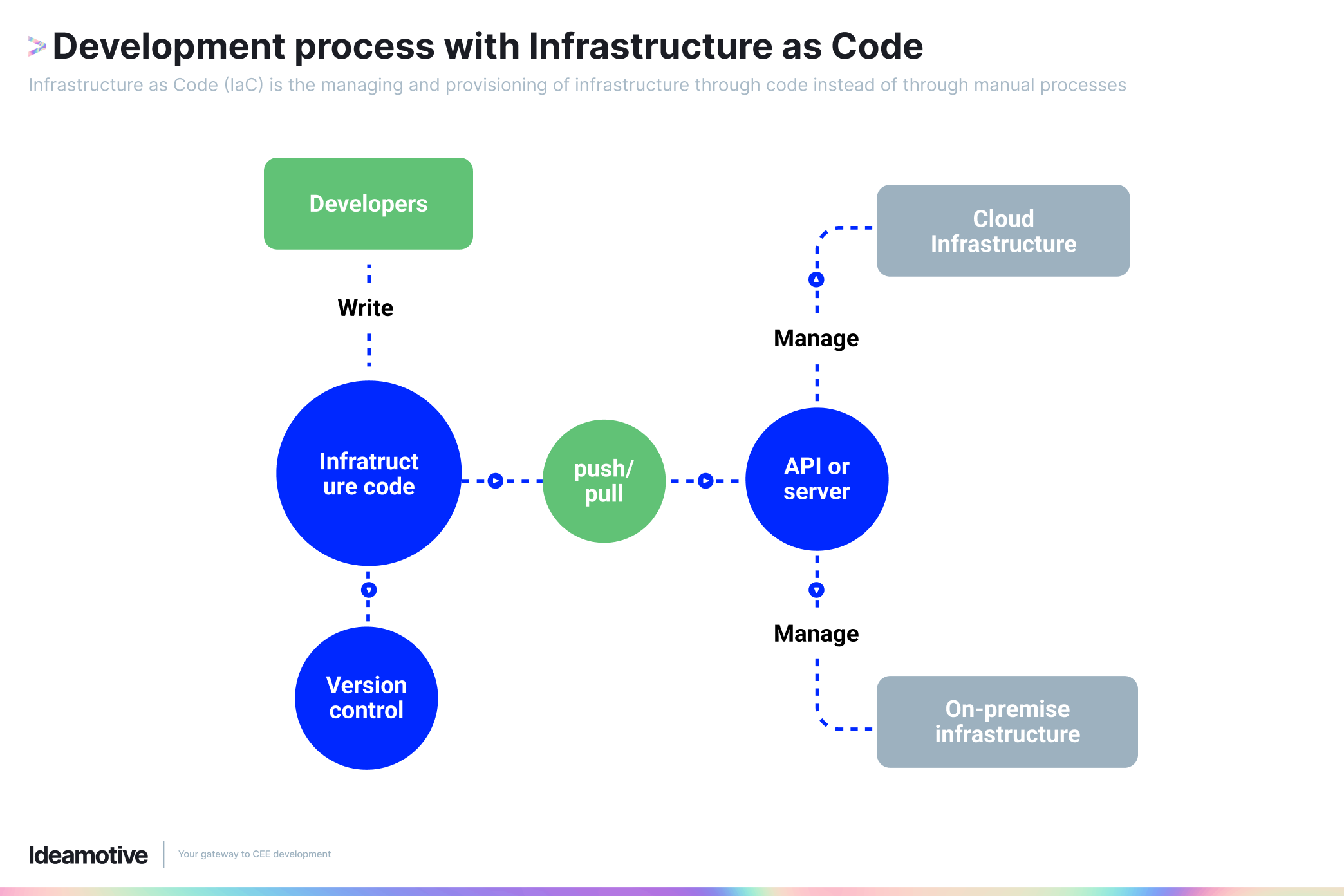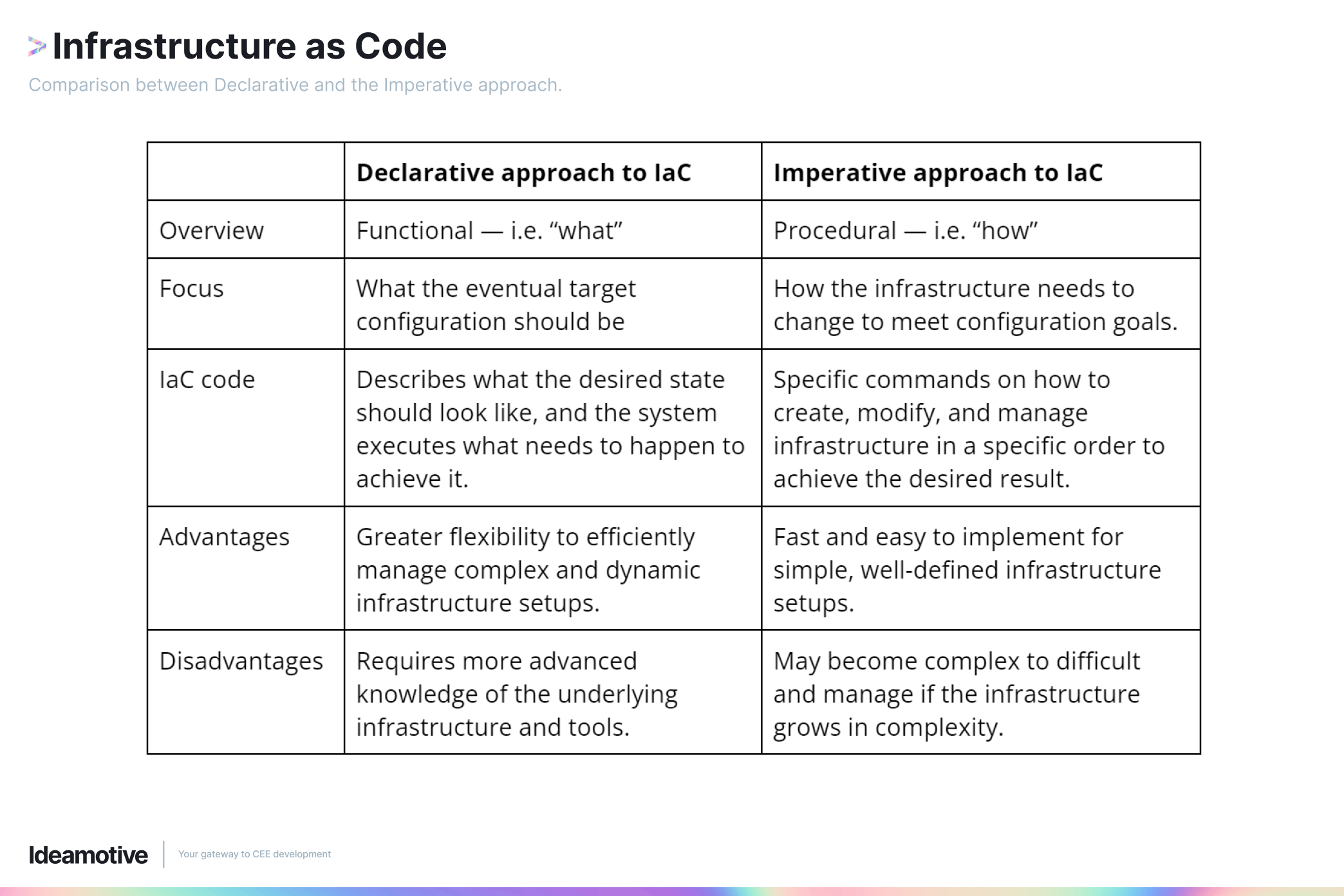In today's fast-paced technological world, startups and scaleups must quickly adapt to changing market trends and customer demands. As a result, they need to ensure that their computing infrastructure is managed efficiently and effectively.
Computing infrastructure refers to the hardware components, such as servers, storage devices, and networking equipment, as well as software components, such as operating systems, databases, and bandwidth.
Managing computing infrastructure supports the flow, storage, processing, and data analysis of web applications or websites built upon it. The traditional process of managing infrastructure involves manually configuring hardware devices and software applications—a costly, time-consuming, and error-prone process.

Infrastructure as Code (IaC) is a novel approach that can help startups and scaleups eliminate the investment and hassle of managing their own computing infrastructure.
IaC also simplifies software development by helping developers avoid configuration drift, automate infrastructure provisioning and management, reduce manual processes, and improve infrastructure management. This article will explore the benefits of adopting IaC for startups and scaleups.
What is Infrastructure as Code (IaC)?
Infrastructure as code (IaC) is a DevOps methodology and versioning used in software development to provision and manage computing infrastructure through code.
The fundamental principle of IaC is to eliminate manual processes by treating infrastructure the same way that DevOps engineers treat code. Like application code, IaC is stored in a version management or source control system that can track and review changes to code using a version control system.
There are two approaches to IaC—the declarative and the imperative approach. Here’s a quick comparison of the two approaches.

Infrastructure as Code tools
Infrastructure as Code (IaC) tools are software platforms or frameworks that automate creating, modifying, and managing infrastructure. These tools use either a pull or push method or a combination of both.
The pull method pulls the configuration from the controlling server to the server that is to be configured, while the push method pushes the configuration from the controlling server instead.
Some popular IaC tools include:
- Amazon Web Services (AWS):
AWS offers numerous services to define IaC, including AWS CloudFormation, AWS Cloud Development Kit, AWS Cloud Development Kit for Kubernetes, AWS Cloud Development Kit for Terraform, and AWS Cloud Control API.
- Terraform:
An open-source tool released by HashiCorp that is compatible with AWS, Azure, and Google Cloud platforms. It utilizes the push method and is written in Go.
- Ansible:
An open-source automation tool released by RedHat. It utilizes the push method and is written in the programming language Python.
- Puppet:
A tool that supports both the push and pull method. Supports numerous programming languages, including C++, Clojure, and Ruby.
- Chef:
A configuration management tool that is written in Ruby and Erlang. Utilizes the pull method.
- Otter:
Released by Inedo and built specifically to support Windows, it utilizes the push method and uses a YAML-based configuration language.
- SaltStack:
Also known as Salt, this IaC tool uses both the push and the pull method. It is written in Python.
- CFEngine:
Utilizes the push method. Unlike other tools mentioned, it only supports the declarative approach, not both imperative and declarative approaches.
Benefits of adopting Infrastructure as Code (IAC) for startups and scale-ups
By adopting IaC and freeing themselves from having to manage infrastructure manually, startups and scaleups can enjoy several benefits, including:
- Automating infrastructure provisioning and management
Automation streamlines many DevOps processes, allowing startups and scaleups to develop and release changes faster, with less risk and reduced cost, to gain a competitive advantage.
- Reduce manual processes
With IaC, DevOps engineers can quickly make infrastructure changes. This gives startups and scale-ups greater agility to respond to market changes and dynamic customer demands quickly.
- Improved infrastructure management
By managing infrastructure through code, startups, and scaleups can automate the process of allocating resources to achieve speed and agility, which are critical for success.
- Avoid configuration drift
With integrated version control, IaC provides a consistent and repeatable way to manage infrastructure. This avoids configuration drift caused by inconsistencies.
- Defined Infrastructure
By providing a defined infrastructure, IaC acts like a blueprint that unifies DevOps teams to work together rapidly, efficiently, and reliably at scale.
- Supports DevOps practices
Automation and version control of IaC makes it easier to adopt DevOps practices emphasizing collaboration, communication, and continuous improvement throughout the software delivery lifecycle.
- Source code management
Using source code to manage infrastructure resources enables DevOps teams to collaborate more effectively by providing shared language and framework. It also reduces errors, allowing startups and scaleups to move quickly and efficiently.
- Enforce the desired state
With IaC tools, DevOps engineers can enforce the desired state of infrastructure by detecting and correcting any configuration drift with less effort.
How does Infrastructure as Code (IaC) work?
Startups and scale-ups wanting to implement IaC will require the following five components needed for IaC to work:
- Programming languages
Programming languages will enable teams to write code that defines the desired state of their infrastructure resources. The most common programming languages used for IaC include YAML, JSON, HCL, and Python.
- Infrastructure as Code Tools
IaC tools are designed to reduce inconsistent environments and allow DevOps engineers to provision and configure infrastructure resources automatically.
- Operating Systems
IaC needs to run on operating systems that allow the code to communicate with the hardware of a computer or server, such as Linux, Unix, and Windows.
- Physical Hardware
Physical hardware is needed to execute code instructions and perform the intended function of IaC, as well as support other infrastructure resources such as databases and storage.
- Data Centers
Whether on-premise or utilized as a cloud service, data centers provide the necessary hardware components that are managed through IaC.
Conclusion
In conclusion, startups and scaleups can benefit significantly from adopting infrastructure as code practices.
The benefits of IaC include the ability to automate infrastructure provisioning and management, reduce manual processes, improve infrastructure management, avoid configuration drift, define infrastructure, use DevOps practices, manage infrastructure as source code, and maintain a desired state.
By adopting IaC, startups and scaleups can efficiently and effectively manage their infrastructure, enabling them to focus on their core business objectives.












